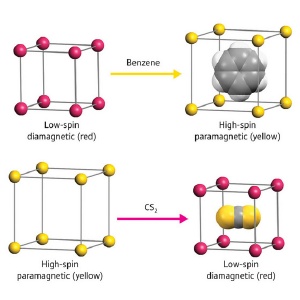Jun 11 2009
When we smell an aroma or taste a flavor, we convert a chemical stimulus - adsorption of a particular molecule - into an information signal. Researchers are seeking to reproduce such interactions, in a simplified form, to develop new types of chemical sensors for practical and safety applications.
 Schematic diagram of magnetic chemo-switching by guest molecules. When the diamagnetic low-spin porous polymer (top left, red) adsorbs benzene, the polymer expands to form the paramagnetic high-spin state (top right, yellow). Conversely, when the high-spin porous polymer (bottom left, yellow) adsorbs CS2, the polymer shrinks to the low-spin state (bottom right, red).
Schematic diagram of magnetic chemo-switching by guest molecules. When the diamagnetic low-spin porous polymer (top left, red) adsorbs benzene, the polymer expands to form the paramagnetic high-spin state (top right, yellow). Conversely, when the high-spin porous polymer (bottom left, yellow) adsorbs CS2, the polymer shrinks to the low-spin state (bottom right, red).
One approach is to use materials known as porous coordination polymers. Consisting of an ordered framework of inorganic metals linked together through carbon-based connectors, these polymers are extremely flexible, allowing large amounts of gas molecules to be adsorbed within the pores. Moreover, adsorption of guest molecules can alter the physical properties of the material.
Now, an international team of researchers has developed a route to detect adsorption through reversible chemo-switching of the magnetic properties of a porous coordination polymer*. According to lead author Masaaki Ohba, a guest researcher at the RIKEN SPring-8 Center and an associate professor at Kyoto University, because the chemo-switching occurs at room temperature, this polymer can be developed into new environmentally responsive materials.
In the team’s polymer, iron and platinum atoms are joined into a regular cubic framework through a cyclic carbon–nitrogen molecule called pyrazine and cyanide connection units. The spin state of the iron atoms—the number of unpaired electrons that determine magnetism—is dependent upon their proximity to the organic connectors.
“The spin state directly relates to the bond distance between iron and the organic connectors,” explains Ohba. “A short bond distance stabilizes the low-spin state, while a long bond distance stabilizes the high-spin state.”
Ohba and colleagues found that adsorption of certain molecules into the porous polymer altered the bond distances between iron and the organic connectors, setting off a switching of the magnetic spin state. When the polymer is initially in the low-spin, or diamagnetic, state, adsorption of gases such as benzene, water, and alcohols causes expansion of the polymer framework—and a switch to the high-spin, or paramagnetic, state.
In contrast, adsorption of carbon disulfide (CS2) gas by a polymer in the high-spin state shrinks the framework, and switches the magnetism to the low-spin state. Even after guest molecules are removed, the polymer retains its magnetic state—a form of non-volatile molecular memory.
“These porous coordination polymers combine properties such as gas adsorption and storage with the physical properties incorporated in their frameworks,” says Ohba. “They can be processed into nanoscale particles or films for applications such as chemical sensors and molecular memories.”
- Ohba, M., Yoneda, K., Agusti, G., Muñoz, M.C., Gaspar, A.B., Real, J.A., Yamasaki, M., Ando, H., Nakao, Y., Sakaki, S. & Kitagawa, S. Bidirectional chemo-switching of spin state in a microporous framework. Angewandte Chemie International Edition published online, 17 Mar 2009 (doi: 10.1002/anie.200806039).